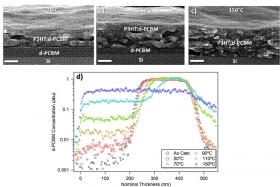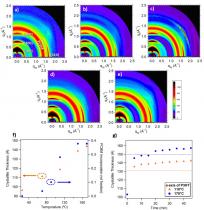The affordable production of the state-of-the-art silicon-based photovoltaics is limited by a need for large-area silicon substrates with low electronic defect densities.1 Organic photovoltaics (OPVs) offer the potential for fabrication at low cost over virtually any size substrate due to their solution processability.2 OPVs have achieved efficiencies near 8%, close to the estimated 10% needed to achieve economic viability,2,3 due to the improvement in solar spectral coverage4 and reduction of optoelectronic loss processes in the cells.3,5 This performance is generally obtained using a bulk heterojunction (BHJ), which is a blend of an electron-donating polymer and an electron-accepting fullerene. Further improvements in efficiency require a better fundamental understanding of the morphology of the electron-donor and acceptor phases within the active layer of BHJ OPVs.
The power conversion efficiency of a BHJ is directly related to the internal morphology of the blended polymer and fullerene. Photogenerated excitons must reach the interface between the donor and acceptor materials to generate free charge carriers. In efficient devices, the photogenerated carriers must have a continuous transport path to the electrodes. There is much evidence that both the generation and collection of charges is highly dependent on the morphology (i.e. size, shape, texture, and phase distribution) of the active layer. Currently, the phase-separated morphology is difficult to control and characterize, and empirical processing methods are used to optimize OPVs.
One of the most extensively studied OPV system is formed from blends of poly(3-hexyl thiophene) (P3HT) and[6,6]-phenyl-C61-butyric-acid-methyl-ester (PCBM). However, the internal film structure and evolution during the typical thermal annealing processing is still a topic of intense debate.
The aim of this work was to develop a fundamental understanding of the miscibility of P3HT and PCBM by investigating the interdiffusion and evolution in molecular ordering starting from a pure bilayer film. By using a combination of dynamic secondary ion mass spectrometry (DSIMS) and cross-section scanning electron microscopy, we observed interdiffusion within the P3HT/PCBM bilayers at relatively low temperatures (i.e. 50°C). Furthermore, this system rapidly (30 s) resulted in a homogeneous film (disregarding differences in interfacial concentration) when annealed at temperatures commonly used to optimize P3HT:PCBM BHJs (150°C) (Figure 1).
This relatively fast rate of interdiffusion (2.5 x 10-10 cm2/s - dominated by the PCBM diffusion) reveals that PCBM diffuses as molecular species or small aggregates and shows that the BHJ components have significant molecular mobility during nominal thermal annealing conditions. By using 2D grazing-incidence wide-angle x-ray scattering, it was also observed that PCBM diffuses within the P3HT film without changing the P3HT crystallite structure, orientation, or growth (up to equal P3HT:PCBM weight ratios) (Figure 2).
These studies suggest that there is a clear driving force towards a three-phase mixture of P3HT and PCBM from a distinctly heterogeneous structure: pure P3HT crystallites, pure amorphous PCBM, and a mixture of disordered P3HT and PCBM. This gives strong evidence that the BHJ solar cells should have a similar structure.
1. A. Shah, P. Torres, R. Tscharner, N. Wyrsch and H. Keppner, Science, 1999,285, 692-698.
2. G. Dennler, M. C. Scharber and C. J. Brabec, Advanced Materials, 2009, 21, 1323-1338.
3. H. Y. Chen, J. H. Hou, S. Q. Zhang, Y. Y. Liang, G. W. Yang, Y. Yang, L. P. Yu, Y. Wu and G. Li, Nature Photonics, 2009, 3, 649-653.
4. L. M. Campos, A. Tontcheva, S. Gunes, G. Sonmez, H. Neugebauer, N. S. Sariciftci and F. Wudl, Chemistry of Materials, 2005, 17, 4031-4033.
5. A. C. Mayer, S. R. Scully, B. E. Hardin, M. W. Rowell and M. D. McGehee,Materials Today, 2007, 10, 28-33.
6. C. G. Shuttle, B. O'Regan, A. M. Ballantyne, J. Nelson, D. D. C. Bradley and J. R. Durrant, Physical Review B (Condensed Matter and Materials Physics), 2008, 113201 (113204 pp.).
N.D. Treat, M.A. Brady, G. Smith, M.F. Toney, E.J. Kramer, C.J. Hawker, M.L. Chabinyc, "Interdiffusion of PCBM and P3HT reveals miscibility in a photovoltaically-active blend," Advanced Energy Materials, 2011, 1, 82-89.






